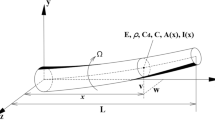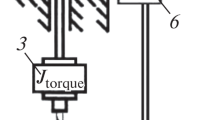Abstract
Shown is a dynamic model of periodic circular cutting of oriented wood tissue in which both the properties of the material and the dynamic properties of the machining system have been considered. The cutting or exciting force is the result of internal and external modulation. The internal modulation is the result of the effect of the properties of the machined material which are given by specific cutting pressure k s, while the external modulation is the consequence of the varying material flux which is affected by relative displacements between the workpiece and the tool. Relative displacements, which are the consequence of the manner of excitation and dynamic properties of the machining system, are also the cause of self-excitation occurrence. As in the process of cutting, the cutting or self-exciting force depends on relative displacements between the tool and the workpiece, the dynamic model developed is non-linear. By simulation of a dynamic model it is possible to analyse the process of cutting wood tissue in its entirety, and it can thus be employed to optimize the selection of tools and the processing parameters of machining.
Zusammenfassung
Dargestellt wird ein dynamisches Modell der periodischen bogenförmigen Spannung des orientierten Holzgewebes, in dem sowohl die Eigenschaften des Materials als auch die dynamischen Eigenschaften des Bearbeitungssystems berücksichtigt sind. Die Schnitt- bzw. Erregungskraft ist die Folge von innerer und äußerer Modulation. Die innere Modulation ist das Resultat des Einflusses der Eigenschaften des Bearbeitungssystems, die mit spezifischem Schnittdruck k s angegeben werden; die äußere Modulation ist aber die Folge des veränderlichen Materialflusses, der durch die relativen Verschiebungen zwischen dem Werkstrück und dem Werkzeug beeinflußt wird. Die relativen Verschiebungen, welche die Folge der Erregungsweise und dynamischen Eigenschaften des Bearbeitungssystems sind, sind auch die Ursache für das Entstehen der Selbsterregung. Da die Schnitt-bzw. Erregungskraft im Spanungsvorgang von den relativen Verschiebungen zwischen dem Werkzeug und dem Werkstück abhängt, ist das entwickelte dynamische Modell nichtlinear. Mit der Simulation des dynamischen Modells ist es möglich, den Vorgang der Spanung des Holzgewebes in seiner Ganzheit zu analysieren und das Modell kann zur Optimierung der Auswahl von Werkzeugen und technologischen Parametern der Bearbeitung dienen.
Similar content being viewed by others
References
Axelsson, B. O. M.; Lundberg, Å, S.; Grönlund, J. A. 1993: Studies of the main cutting force at and near a cutting edge. Holz Roh-Werkstotf 51(1): 43–48
Bučar, B. 1990: Orthogonal cutting dynamic. Master of science thesis. University of Ljubljana, Biotechnical Faculty, Department of Wood Science and Technology, 210 pp
Haris, C. M. 1987: Schock vibration handbook. Third edition. McGraw-Hill book company, 1355 pp
Inoue, H.; Mori, M. 1979: Effects of cutting speed on chip formation and cuttingresistance in cutting of wood parallel to the grain. Mokuzai Gakkaishi 25(1): 22–29
Kivimaa, E. 1952: Die Schnittkraft in der Holzbearbeitung. Holz Roh-Werkstoff 10(3): 94–108
McKenzie, W. M. 1960: Fundamental aspects of wood cutting process. Forest Prod. J. 10(9): 447–456
McKenzie, W. M. 1961: The relationship between the cutting properties of wood and its physical and mechanical properties. Forest Prod. J. 11(6): 287–294
McMillin, C. W. 1958: The relationship of mechanical properties of wood and nosebar pressure in the production of veneer. Forest Prod. J. 8(1): 23–32
Minis, I. E.; Magrab, E. B.; Pandelidis, I. O. 1990: Improved methods for the prediction of chatter in turning. Part 1: Determination of structural response parameters. J. Eng. Ind. 112(2): 12–20
Mori, M. 1971: An analysis of cutting work in peripheral milling of wood III. Variation of cutting force in inside cutting of wood with router-bit. Mokuzai Gakkaishi 17(10): 437–442
Seto, W. W. 1964: Mechanical vibrations. Shaum’s outline series. McGraw-Hill book company, 199 pp.
Stewart, H. 1969: Effect of cutting direction with respect to grain angle on the quality of machined surface, tool force components, and cutting friction coefficient. Forest Prod. J. 19(3): 43–46
Stewart, H. 1971: Chip formation when orthogonally cutting wood against the grain. Wood Science 3(4): 193–203
Stewart, H. 1979: Analysis of orthogonal woodcutting across the grain. Wood Science 12(1): 38–45
Author information
Authors and Affiliations
Rights and permissions
About this article
Cite this article
Bučar, B., Kopač, J. Dynamic model for the determination of instability of periodic circular cutting of wood tissue. Holz als Roh- und Werkstoff 54, 19–25 (1996). https://doi.org/10.1007/s001070050126
Issue Date:
DOI: https://doi.org/10.1007/s001070050126




